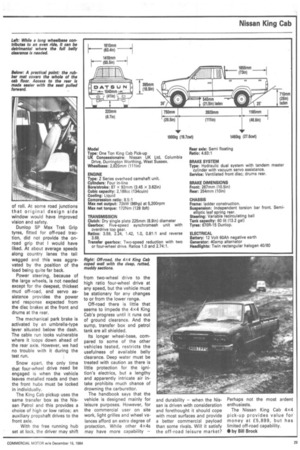THE LIGHT 4x4 pickup market is divided into two main
Page 30

Page 31

If you've noticed an error in this article please click here to report it so we can fix it.
groups: commercial and pleasure. When a manufacturer aims to compete in both groups with one model, is it possible to satisfy either one?
This was a question I set out to answer when testing the Nissan King Cab one-ton pickup introduced to Britain in June.
This vehicle has pleasing lines and a good paint finish. The body panels are reasonably plain and their slight curves should not make repair work complicated. The wheel-arches incorporate slightly protruding plastic valances, but these are sufficiently pliable to withstand the occasional knock.
The chassis-mounted pickup bed sacrifices a foot or so in length as a contribution towards cab comfort, but easily accepted a load of sandbags weighing around 8 3 Okg (16.3cwt) — one of the best cross-country payloads in this group.
While the wheel-arches intrude into the floor area, they are located well forward. The tailgate folds down to the horizontal, or beyond if the supports are disconnected.
The test vehicle was supplied with a body liner while the load restraint cage protects the rear of the cab up to roof height. Sheet ties, recessed in a shallow groove running the length of the rear body section, are easily accessible.
The cab, unusually long for a vehicle of this type, was designed with a short window be hind the B-post, but this has since been blanked off for the British market in order to avoid the risk of attracting car tax.
Space behind the cloth-covered seats can be used to stow equipment or protective clothing and also provides ample seat adjustment. While radio, cigarette lighter, ash tray, heater, glove box and comprehensive tool kit are standard fitments, Nissan omitted to include a coat hook.
The floor area is entirely coy ered with a rubber mat; after all, there is no sense in fitting carpet where mud will be trodden in.
The Nissan has a long bonnet and it is difficult to see the front nearside corner.
The Nissan four-cylinder ZSeries 2,188cc overhead cam engine has a compression ratio of 8.5 to 1 and the engine runs on two-star petrol. It produces 72kW (96hp) at 5,200rpm and 172Nm (128 lbft) of torque at 3,20Orpm.
Over 650km of mixed running, including motorway, Aroad, town and off-road conditions, the vehicle returned an overall fuel consumption of 13.1 lit/100km (21.49mpg) with a full load.
A fifth overdrive top gear allowed maximum motorway speed cruising without effort. In-cab noise measured at 50 and 60mph was recorded as 74 and 75.5 dB(A) respectively.
The wind force overcame the mirror support spring and banged the head into the side window. However, my overall impression was one of relative quietness with only minimal engine and transmission noise intruding into the cab.
As with most light 4x4s, the driving position is quite high, which helps to give good visibility, and here did not appreciably accentuate the degree
of roll. At some road junctions. that original design side window would have improved vision and safety.
Dunlop SP Max Trak Grip tyres, fitted for off-road traction, did not provide the onroad grip that I would have liked. At about average speeds along country lanes the tail wagged and this was aggravated by the position of the load being quite far back.
Power steering, because of the large wheels, is not needed except for the deepest, thickest mud off-road, and servo assistance provides the power and response expected from the disc brakes at the front and drums at the rear.
The mechanical park brake is activated by an umbrella-type lever situated below the dash. The cable run looks vulnerable where it loops down ahead of the rear axle. However, we had no trouble with it during the test run.
Snow apart, the only time that four-wheel drive need be engaged is when the vehicle leaves metalled roads and then the front hubs must be locked in individually.
The King Cab pickup uses the same transfer box as the Nissan Patrol and this provides a choice of high or low ratios; an auxiliary propshaft drives to the front axle.
With the free running hub set at lock, the driver may shift
from two-wheel drive to the high ratio four-wheel drive at any speed, but the vehicle must be stationary for any changes to or from the lower range.
Off-road there is little that seems to impede the 4x4 King Cab's progress until it runs out of ground clearance. And the sump, transfer box and petrol tank are all shielded.
Its longer wheel-base, compared to some of the other vehicles tested, restricts the usefulness of available belly clearance. Deep water must be treated with caution as there is little protection for the ignition's electrics, but a lengthy and apparently intricate air intake prohibits much chance of drowning the carburettor.
The handbook says that the vehicle is designed mainly for leisure purposes. However, for the commercial user on site work, light grilles and wheel valances afford an extra degree of protection. While other 4x4s may have more capability — and durability — when the Nissan is driven with consideration and forethought it should cope with most surfaces and provide a better commercial payload than some rivals. Will it satisfy the off-road leisure market? Perhaps not the most ardent enthusiasts.
The Nissan King Cab 4x4 pick-up provides value for money at £5,899, but has limited off-road capability.
• by Bill Brock












































































